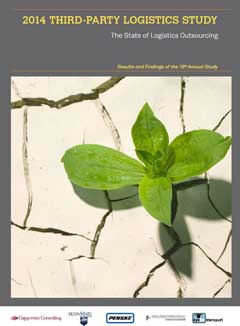From SCDigest's On-Target E-Magazine
- Dec. 2, 2013 -
Supply Chain News: Highlights from the 18th Annual Third-Party Logistics Study Part 2
Big Data and Logistics; New Talent for the New Normal; Profiting from Global Trade Management
SCDigest Editorial Staff
Two weeks ago, we summarized key findings in the 18th annual Third Party Logistics Study, released once again at the annual CSCMP conference in Denver and led as always by Dr. John Langley of Penn State (see Highlights from the 18th Annual Third-Party Logistics Study.)
As promised then, this week SCDigest will summarize some of the "featured topic" sections that accompanied the main body of the report.
There was in fact a rather large section on opportunities to better utilized "big data" in logistics. So what is big data anyway? The report chooses to use the definition offered not long ago by Garter, which is that "Big data is high-volume, -velocity and -variety information assets that demand cost-effective, innovative forms of information processing for enhanced insight and decision making."
SCDigest Says: |
 |
| This report almost always has some of these seeming contradictions, indicating the complex nature of shipper-3PL relationships. |
|
What Do You Say?
|
|
|
|
Now that that's cleared up, Gartner and the report note that of course all this data analysis has to be clearly connected to real business problems, implying that there is some risk companies will be shifting through massive amounts of data just hoping to find some insights that are meaningful.
8% of shippers and 5% of 3PLs say their companies have started big data programs that connect to the supply chain, while 22% of both groups say that are planning such big data initiatives.
The report offers a couple of big data examples. FedEx is putting sensors on high value items to track speed and conditions as it moves these parcels, offering the potential to apply analytics to all this data to reduce supply chain reaction times to avoid delays in shipments.
Nike has fully mapped it entire supply chain, and is apparently using some type of analytics to identify areas of risk as they emerge, especially in global suppliers.
The report suggests that areas like order management, synthesizing disparate data sources, and supply chain visibility are all areas that can benefit from a "big data" approach, but SCDigest is not sure any of those per se involve big data, which implies some kind of analytics be connected to the data. Simply having a lot of data does not, in fact, mean a company has entered the big data realm.
The bottom line: we are still very early in the game when it comes to big data and the supply chain, and there is frankly still a lot of fuzziness as to what the term really means and where companies can really drive supply chain value from it.
In fact, the report notes that 59% of shippers and 48% of 3PLs report that their supply chain organizations believe they need to "further develop the more traditional requirements of storage, processing, and information architecture before becoming seriously involved in the use of big data."
Benefiting from Preferential Trade Agreements
The number of preferential trade agreements that reduce or eliminate customs and duties between countries to rise, up to something like 300 such active deals worldwide, with important new agreements, such as the Trans-Pacific Partnership and the Transatlantic Free Trade Area (TAFTA), currently being negotiated.
The report states, however, that many companies fail to reap the full benefits of such agreements because they are unable to navigate all the rules and filings that come with the deal.
 "As countries engage in multiple, overlapping preferential trade agreements, the task of keeping track of variances in tariff schedules, rules of origin, customs procedures, implementation timeframes, and so on, becomes increasingly unwieldy and complex," the report says, adding that "The terms of PTAs tend to change rapidly and arbitrarily, further complicating their management." "As countries engage in multiple, overlapping preferential trade agreements, the task of keeping track of variances in tariff schedules, rules of origin, customs procedures, implementation timeframes, and so on, becomes increasingly unwieldy and complex," the report says, adding that "The terms of PTAs tend to change rapidly and arbitrarily, further complicating their management."
The report notes the potential to use one of several commercially available "global trade management" solutions to better navigate the opportunities of preferential trade agreements. These tools keep up to date with the various requirements of the agreements, and then combine rules engines and workflow capabilities to capture the financial opportunities and file the correct documentation associated with each agreement.
The report notes that the most advanced users of GTM tools apply them early in the product design, sourcing and distribution planning process, so that the optimal decisions on where to make and how to move a new product can be achieved, enabling them to calculate a "total landed cost" that encompasses all duties, tariffs, rebates, etc. – something few companies do well today.
The section ends with a pitch for considering global 3PLs as a partner to optimize global trade management – though SCDigest will note their ability to do so will depend heavily on the underlying tools they have bought or built and their capability to use them.
(Distribution/Materials Handling Story Continues Below
)
|